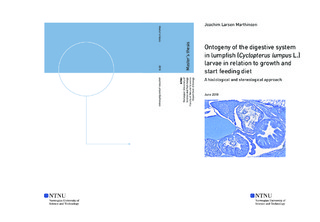| dc.description.abstract | Global aquaculture production of Atlantic salmon (Salmo salar) has stabilized since 2012 due to high prevalence of the ectoparasitic sea lice (Lepeophtheirus salmonis). Deployment of lice-eating cleaner fish is considered one of the most effective and sustainable methods to control sea lice infestations in salmon cages, of which lumpfish (Cyclopterus lumpus) is the most used and commercially produced species in Norway. The Norwegian aquaculture lumpfish production has escalated greatly since 2012 but is currently characterized by variable growth and survival during the larval stage. Little is still known about nutritional requirements and digestive system development of lumpfish larvae, the latter of which is determining for larvae s capacity to assimilate nutrients required for all metabolic processes.
The present study aimed to describe digestive system ontogeny in lumpfish from hatching to 50 days post hatch (dph) based on histological and stereological methods and to evaluate effects of different start feeding regimes on growth, survival and development of the liver, stomach and gut. Ontogeny and dietary effects were investigated by conducting a start feeding experiment in which three triplicate groups received different diets during the start feeding period (2-22 dph). Larvae from one group were fed enriched Artemia while two groups were offered Acartia tonsa, either for the full start feeding period or with an early weaning to formulated diet 6-8 dph. Larvae from all groups were weaned 20-22 dph and fed the same inert diet until the experiment ended 51 dph.
The alimentary canal of lumpfish was divided into the esophagus, primordial stomach, midgut and hindgut by hatching, at which time it was coiled and open at both ends. Newly hatched larvae had a differentiated liver containing large, irregularly shaped glycogen-like vacuoles and an exocrine pancreas with numerous zymogen granules. The stomach had developed gastric glands 10 dph (6.6 6.8 mm standard length) and was divided into the cardia, pylorus and fundus by 34 dph. At this time the stomach lumen volume had increased significantly (8.0 9.1 mm standard length) and pyloric caeca formed in the anterior midgut. Feeding with Artemia greatly improved larval growth rates, survival after yolk resorption 21-34 dph and resulted in more rapid stomach development compared to both groups initially fed A. tonsa. Larvae showed lower hepatocyte cell and nucleus area sizes, absence of hepatic vacuoles and reduced midgut epithelium height during the period they were fed A. tonsa. These effects were pronounced on the liver of larvae from both groups fed A. tonsa by 10 dph and were reversed after weaning to dry feed, indicating that the liver accurately reflected larval nutritional status at the time of sampling. On the other hand, reduced midgut epithelium height was not observed until 21 dph, suggesting that midgut epithelium height might be a good indicator for prolonged starvation in lumpfish. | |

